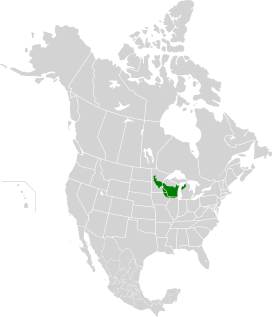Upper Midwest forest–savanna transition facts for kids
Quick facts for kids Upper Midwest forest–savanna transition |
|
|---|---|

Ecoregion Preserve (Devil's Lake State Park, Wisconsin)
|
|
 |
|
| Ecology | |
| Realm | Nearctic |
| Biome | Temperate broadleaf and mixed forest |
| Borders |
List
|
| Bird species | 215 |
| Mammal species | 62 |
| Geography | |
| Area | 166,100 km2 (64,100 sq mi) |
| Countries | United States and Canada |
| States/Provinces | Minnesota, Wisconsin, Michigan, Iowa, Ontario and Manitoba |
| Conservation | |
| Habitat loss | 62.5% |
| Protected | 4.7% |
The Upper Midwest forest–savanna transition is a special natural area. It's like a bridge between two different types of land. To the west, there are wide tallgrass prairies. To the east, you find thick temperate deciduous forests. This area is called an ecotone, which means it's a place where two ecosystems meet and blend.
This unique region is mostly found in the Upper Midwest of the United States. It's part of the Upper Mississippi River basin. Sadly, this amazing habitat is now in danger. Less than 5% of its original area is left. This is mainly because of too much animal grazing and land being turned into farms.
Contents
Why Fire is Important Here
Historically, wildfires were very important in this area. They helped shape the forests and the plants that grew there. Because of these fires, the tree tops, called the canopy, were not very dense. This meant there was plenty of sunlight reaching the ground.
How Fire Shapes the Land
The number and types of plants in this area were largely controlled by how often fires happened. When fires were more frequent, plants like grasses, forbs (flowering plants), shrubs, and sedges grew more. At the same time, the number of trees and their size would decrease. This balance kept the savanna open and healthy.
What Happened After Fire Stopped?
After European settlers arrived, they stopped using fire to manage the land. This changed everything. Most savannas slowly turned into closed canopy woodlands. This means the trees grew very close together, blocking out the sun. Plants that like shade and don't do well with fire started to take over. These new species replaced the original plants that needed fire to thrive.
What Plants Live Here?
This region is home to many different plants. The trees here are often a mix of those found in prairies and those found in forests.
Common Trees You'll Find
Here are some of the trees you might see in this transition zone:
- Quercus macrocarpa (Bur oak)
- Tilia americana (American basswood)
- Acer saccharum (Sugar maple)
- Quercus rubra (Red oak)
Where Can We Still See This Habitat?
In 1985, a study found that only about 26 square kilometers (10 square miles) of oak savanna remained. That's a tiny fraction, only about 0.02%, of what was here before European settlement. These remaining areas are spread out and broken up, which is called habitat fragmentation.
Special Places That Remain
None of the remaining habitat is part of National Forests. Instead, they are managed by state organizations like the Department of Natural Resources or federal groups like the Fish and Wildlife Service. Some of these important areas include:
- Devil's Lake State Park in south-central Wisconsin
- Savanna Army Depot in northwestern Illinois
- Parts of the Upper Mississippi River National Wildlife and Fish Refuge in eastern Minnesota and western Wisconsin
- Richard J. Dorer Memorial Hardwood State Forest in southeastern Minnesota
- Whitewater State Park in southeastern Minnesota
- Necedah National Wildlife Refuge in central Wisconsin
- Horicon Marsh in southeastern Wisconsin
- Kettle Moraine State Forest in southeastern Wisconsin
- Kettle Marine State Trooper in southeastern Wisconsin

